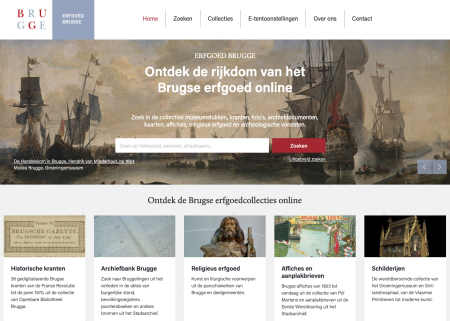ErfgoedBrugge.be: Digital Heritage Without Borders
Researchers and travellers from all over the world are familiar with heritage collections in Bruges. But the ErfgoedBrugge.be portal, where these valuable collections can be accessed online, hardly reaches an international, non-Dutch-speaking audience at all. And because six million tourists visit heritage in Bruges every year, the city now wants the portal to evolve into a multilingual site. This project, with support from meemoo among others, is helping the city to investigate how it can better reach a wider international audience by making all the information on the portal available in different languages.

Screenshot website erfgoedbrugge.be
Challenge
The ErfgoedBrugge.be website is home to the Musea Brugge collection of photos, old newspapers, old maps and other historical sources. These images can be interesting for speakers of any language, but other information is currently only available in Dutch. This is because the online platform is currently fed by a central data layer which only exists in Dutch. The challenge is therefore to make the images accessible in a less language-dependent way.
But what information are international visitors to Bruges interested in? And which languages should be available? The City of Bruges aims to answer these questions in this project, and ultimately translate them into actual adaptations on the portal.
Our role
Meemoo is supporting the project in identifying the needs of specific target audiences and the technical requirements that the portal has to satisfy. A user survey was carried out in an initial phase, and we helped to determine what questions had to be answered and which target audiences we should ask.
We’re also helping to explore technical aspects of (automatic) multilingualism, and collaborated on defining the technical requirements and analysis options for an app that tests which languages and information are requested most often.
In a later phase of the project, we will also provide Erfgoed Brugge with training on open data and Wikimedia platforms. This training will offer better insights into metadata standardisation and enrichment, an important aspect of this project. We will ultimately also help to draw up a manual for multilingual, digital heritage data.
Approach
Phase 1 (2019-2020): Research the potential of a multilingual central data layer for ErfgoedBrugge.be
The first phase of the project consisted of a user survey on ErfgoedBrugge.be. This provided more insight into the target audiences already being reached, their expectations, and what possibilities they find when using the platform.
The online application LearnMore.be was also developed in collaboration with Open Summer of Code 2019, to measure what languages and information are requested. The app uses data from various sources: Wikidata, Wikipedia, the baroque-themed site from the former Flemish Art Collection (now meemoo), and Brugge in beeld, de mediabank van Brugge (Bruges in pictures, the Bruges media database). We tested the app in two pilot projects in the Groeninge Museum and on Burg Square, reaching over 3,000 visitors in total. These target audiences’ wishes appear to differ greatly from visitors to ErfgoedBrugge.be (e.g. a preference for summarised information and photos).
Finally, research was also carried out into the possibility of re-using existing heritage data within a tourist context. It was established that simply translating metadata and linking to various sources (e.g. own database, Wikimedia and the former Flemish Art Collection) was not sufficient. You still need to take the target audience and medium (e.g. an online application) into account when editing texts and images.
Phase 2 (2020-2021): Digital Heritage Without Borders – international accessibility and multilingual searchability of data on ErfgoedBrugge.be
In the second phase of the project, we explored methods for making the data accessible to international target audiences by publishing it as searchable and enriched multilingual linked data. Meemoo helped Erfgoed Brugge to make a set of objects from the Raakvlak archaeological depot accessible on Wikidata and Wikimedia Commons in the context of our Wikimedia upload workshop. Finally, we also experimented with visualisations of the data based on SPARQL queries.
Phase 3 (2021-2022)
The implementation will start in this phase. We will draw up a manual to provide guidelines to the cultural heritage sector on how digital heritage data can be brought to international target audiences.
Partners
Erfgoedcel Brugge (Bruges heritage body)
Openbare Bibliotheek Brugge (Bruges public library)
Stadsarchief Brugge (Bruges city archive)
Toerisme Brugge (Visit Bruges)
Raakvlak (Bruges and surrounding area intangible heritage)
FARO (Flemish Institution for Cultural Heritage)
